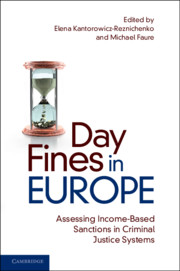Book contents
- Day Fines in Europe
- Day Fines in Europe
- Copyright page
- Contents
- Figures
- Tables
- Contributors
- Acknowledgements
- Abbreviations
- 1 Introduction
- 2 Theoretical Perspectives on Day Fines
- 3 Day Fines in Finland
- 4 Day Fines in Sweden
- 5 Day Fines in Denmark
- 6 Day Fines in Germany
- 7 Day Fines in Austria
- 8 Day Fines in Hungary
- 9 Day Fines in France
- 10 Day Fines in Portugal
- 11 Day (Unit) Fines in England and Wales
- 12 Day Fines in Slovenia
- 13 Day Fines in Spain
- 14 Day Fines in Poland
- 15 Day Fines in Croatia
- 16 Day Fines in Switzerland
- 17 Day Fines in Czech Republic
- 18 Day Fines in Romania
- 19 Comparative Law and Economics Perspective on Day Fines
- Index
- References
19 - Comparative Law and Economics Perspective on Day Fines
Published online by Cambridge University Press: 11 June 2021
- Day Fines in Europe
- Day Fines in Europe
- Copyright page
- Contents
- Figures
- Tables
- Contributors
- Acknowledgements
- Abbreviations
- 1 Introduction
- 2 Theoretical Perspectives on Day Fines
- 3 Day Fines in Finland
- 4 Day Fines in Sweden
- 5 Day Fines in Denmark
- 6 Day Fines in Germany
- 7 Day Fines in Austria
- 8 Day Fines in Hungary
- 9 Day Fines in France
- 10 Day Fines in Portugal
- 11 Day (Unit) Fines in England and Wales
- 12 Day Fines in Slovenia
- 13 Day Fines in Spain
- 14 Day Fines in Poland
- 15 Day Fines in Croatia
- 16 Day Fines in Switzerland
- 17 Day Fines in Czech Republic
- 18 Day Fines in Romania
- 19 Comparative Law and Economics Perspective on Day Fines
- Index
- References
Summary
This chapter, based on the reviewed countries’ experiences, provides a comparative analysis of the day fines system in Europe. It seems that making the sentencing system more equal, and reducing short-term imprisonment, are common goals for countries to adopt day fines. Some countries can be rendered as a success in terms of the extent of implementing day fines and the ability to meet the desired goals. Nevertheless, as the experience of many other countries shows, there can be major challenges for day fines to be properly implemented. The main two challenges identified in this chapter are the complexity of calculating the fine, exacerbated by the frequent lack of guidelines, and a negative perception, derived mainly from lack of understanding of the system (by the public) and lack of support from the sentencers. In this chapter, we provide policy recommendations how to address these two specific challenges, as well as more general recommendations to expand the use of day fines. Given the multiple advantages day fines offer, it seems worth investing in its proper implementation. These recommendations may assist jurisdictions who already implement day fines, well as those interested in introducing this model into their criminal justice system
Keywords
- Type
- Chapter
- Information
- Day Fines in EuropeAssessing Income-Based Sanctions in Criminal Justice Systems, pp. 366 - 388Publisher: Cambridge University PressPrint publication year: 2021

